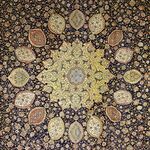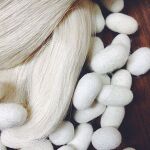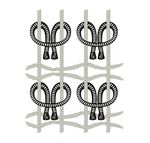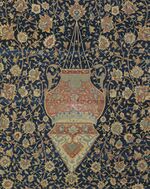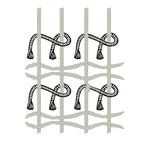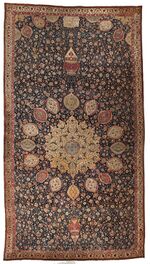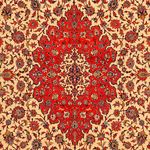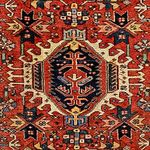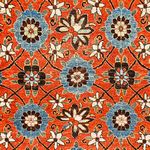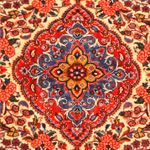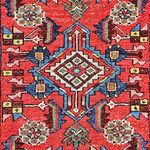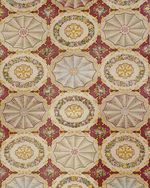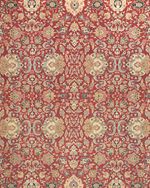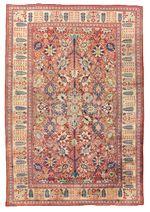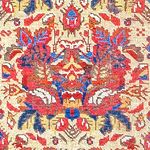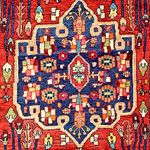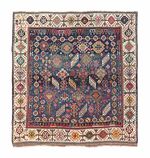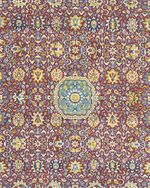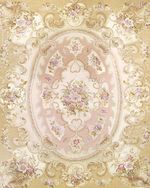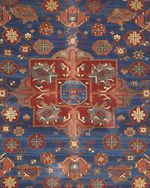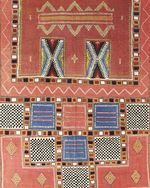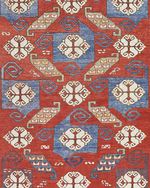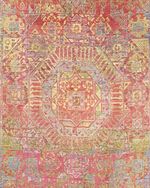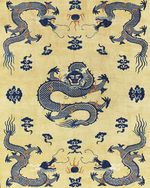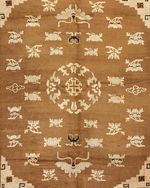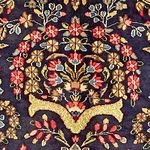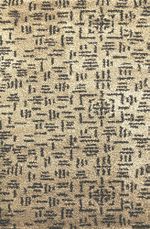WikiRug:Featured Article 2023
Week 11 2023
- week 1
The history of Persian carpet manufacture is fraught with unproven hypotheses, rash assumptions, and confident assertions that flout historical evidence. Indeed, scholars hold widely differing opinions on almost every aspect of the production of Persian carpets. As Edward Gibbon said in another connection, “the melancholy duty is imposed upon the historian” of trying to determine what facts are beyond dispute.
The discovery of the Pazyryk carpet and an even earlier fragment in tombs in Siberia revealed that the manufacture of knotted-pile carpets is of far greater antiquity than had previously been supposed. The oldest previously known pile carpets were manufactured in Anatolia in the 7-8th/13-14th centuries.(Full article...)
- week 2
For centuries Persian carpet weaving has depended primarily on local materials processed by traditional techniques. The introduction of merino wool from Australia was short-lived, and, even after synthetic chemical dyes were introduced around the turn of the 14th/20th century, they were often processed according to traditional techniques. Until the 1320s Š./1940s vegetable dyes continued in common use.
The basic raw materials for carpets are natural fibers, of which sheep wool is important. In different parts of Persia different kinds of sheep are raised, depending on the prevailing climate and available pasturage.(Full article...)
- week 3
Whether the carpet is flat-woven or piled, the basic components are the warps, which run from end to end of the rug, and the wefts[4], which are passed from side to side alternately over and under the warps, thus binding them together to produce the foundation of the carpet.
In pile rugs supplementary weft yarns, or “knots”, are wrapped around the warps between the foundation wefts, then cut; the cut ends project on the surface to form the pile and create the design. Knots are generally tied to pairs of warps. The two basic types of knots found in Persian carpets are the symmetrical and the asymmetrical both of which may be open either to the right or, more commonly, to the left.(Full article...)
- week 4
The most common design format in Persian carpets is a central field enclosed by a border of patterned stripes alternating with narrow bands of solid colors. The borders of Persian carpets generally have three or more patterned bands; the widest is called the “main stripe” and those flanking it “minor” stripes. The narrow bands of solid color that usually separate the main and minor stripes are known as “guards”. Carpet formats may be categorized further as either directional or nondirectional. The former include pictorial, prayer-niche, and naturalistic vegetal designs intended to be viewed from a single vantage point. Nondirectional designs, on the other hand, are coherent when viewed from any angle; examples include radial designs, as well as abstract repeat patterns associated with tribal weaving.(Full article...)
- week 5
Persian flat-weave structures range from simple interlacing—one set of warps and one set of wefts in various forms of plain weave—to a variety of compound weaves involving additional sets of warps or wefts or both. Patterning and decoration may also be achieved through various flat-weave techniques, including the introduction of supplementary warps, wefts, or both. Occasionally small motifs are worked in a supplementary-weft technique known as knotted and cut pile.
The looms used for flat-woven carpets are of the same basic types as those used for pile carpets. Nomads have traditionally used horizontal ground looms, which are easy to dismantle for the biannual migrations.(Full article...)
- week 6
Since 1966, when Hans Wulff wrote “There is no field in the industrial arts in Persia that is as important as carpet weaving, and yet little is known about its early development”, little new information has become available. Indeed, the evidence for textiles of all kinds in pre-Islamic Iran is very sparse. It is necessary to supplement the few remains of actual textiles with examination of representations in art and other kinds of indirect evidence of production, for example preserved impressions and pseudomorphs from excavations
By the late 2nd millennium b.c. cording was known; the technique was later used in the selvages of carpets. In the tombs at Marlik on the southwest Caspian coast, which date from this period or perhaps the beginning of the 1st millennium b.c., were found fragments of unidentified fabric, including cords and woven bands.(Full article...)
- week 7
Because of the scarcity of surviving materials it is difficult to separate the history of carpet making in Iran from that of the rest of the Islamic world before the Mongol invasion. Furthermore, the kind of rigid distinction between carpet and other textile designs that characterizes later production probably did not exist in the early Islamic period. On surviving fragments and contemporary depictions of both carpets and textiles simple patterns of lozenges, circles, stripes, and the like are the main designs; animal designs on early carpets seem to have been modeled on those of deluxe figured textiles, again suggesting a more general approach to the design of floor coverings at this period.
Textiles as floor coverings. On early Islamic metalwork and ceramics from Iran male figures are commonly depicted seated directly on the ground, with no cushions or textiles beneath them; kings and other important figures, on the other hand, sometimes sit on thrones covered with cloth.(Full article...)
- week 8
Persian carpets that can be indisputably identified a having been produced in the 8-9th/14-15th centuries are virtually nonexistent. One fragment of a pile carpet in the Benaki Museum in Athens has recently been attributed to “Iran or Central Asia” in the 9th/15th century, though the reasons for this attribution are not clear. It is made entirely of wool and measures 14 x 22". Many features of the design link it to Anatolian Saljuq and “Holbein” rugs dated between the 7th/13th and the early 10th/16th centuries.
That carpets were used and produced in Persia in the 8-9th/14-15th centuries has nonetheless been inferred from written sources, both contemporary and slightly earlier.(Full article...)
- week 9
The high point in Persian carpet design and manufacture was attained under the Safavid dynasty. It was the result of a unique conjunction of historical factors—royal patronage, the influence of court designers at all levels of artistic production, the wide availability of locally produced and imported materials and dyes, and commercial acceptance, particularly in foreign markets.
The history of carpet weaving during the first century of Safavid rule can be traced only sketchily. The most important documentary evidence is three carpets with dated inscriptions. The date on a medallion rug in the Poldi Pezzoli collection in Milan has been read by some scholars as 929/1522-23 and by others as 949/1542-43. (Full article...)
- week 10
Isfahan, also spelled Esfahan, is an important city and province located in central Iran. It is the capital of the province and is one of the largest cities in Iran. Isfahan is a historic city and is regarded as symbolic of culture and art dating back to the Safavid Dynasty. Isfahan became the capital city beginning in the late sixteenth century, and the School of Art was established there during this period. Under the Safavids the Islamic Shia sect was established in Persia, and famous mosques and palaces were built in the capital and other cities. Today these buildings are considered some of the finest examples of Persian architecture. In Isfahan the Safavid court also established and supervised the handcrafted art forms of carpet weaving, ceramics, miniature painting, metalwork, velvet manufacturing, and garment printing..(Full article...)
- week 11
Karadja Iran (Persia). Karadja, also spelled Karaja, is a village located in the East Azerbaijan Province of northwestern Iran. The population is Azeri in origin, speaking a Turkic dialect. Karadja rugs and carpets are known in the market from the last quarter of the nineteenth century. These weavings are categorized in the Heriz carpet group.
Karadja carpet designs are geometric, with either a medallion or all-over style. In general, these carpets are known to have one, two, or three medallions in the center field or multiple pendants throughout the field.(Full article...)
- week 12
Varamin rugs are categorized in the trade under two time periods, the last quarter of the nineteenth century and the 1920s to the present day.
Early Varamin rugs were woven by the Shahsavan tribe, which moved south from northwestern Persia and settled in Varamin. These rugs are geometric and sometimes have Minakhani (rosette-linked trellis) motifs with tribal design elements in the field. Other pieces are more strongly geometric, with abstract small medallions and other devices derived from flatwoven mum rugs. The rugs have a wool foundation and a wool pile. The Turkish (symmetric) knot is employed. .(Full article...)
- week 13
Jozan is a town in the Arak (Markazi) Province of west-central Iran and is located near the famous weaving village of Sarouk. Jozan rugs dating from as early as World War I are known in the market. The rugs are categorized as Sarouks because of the similarity in textures; at times they are called "Jozan Sarouk" in the trade.
Jozan rug designs are semi geometric and frequently have a pendant-shaped medallion in the center and a stylized quarter-medallion in each corner of the background. The field has an all-over style of vines with blossoming flowers, flower sprays, and leaves.(Full article...)
- week 14
Zagheh rugs are hand-woven Persian tribal carpets made in the Kurdish nomadic districts of Northeastern Iran. Zagheh is the name given to a group of nomadic people living in the surrounding area of Hamadan. The bright colors and geometric shapes are typical of tribal weaving from this area of Iran. A rug such as this takes a nomadic woman, sometimes working with her daughter, several months of concentrated weaving to complete on a crude loom on the ground outside the family tent. Most rugs woven by tribal people are intended for their own use as floor coverings or sleeping mats.(Full article...)
- week 15
Spain is known for producing some of the earliest European floor coverings. Early carpets were made for royalty, nobility, and the Church. Queen Eleanor of Castile (1241-1290) brought carpets to England after her marriage to King Edward I (r. 1272-1307) in the latter part of the thirteenth century. These carpets were from Granada and created great interest in England, as carpets were practically unknown in Britain at that time.
Spain became the leader in commercial carpet manufacturing in Europe by the fifteenth century.(Full article...)
- week 16
Rugs of Pakistan are woven on a cotton foundation with the asymmetric knot. The cheapest grades may have jute wefts. Wools are local or blended with New Zealand or Australian wool for the finer grades of rugs. Where designs copy Persian models, offset warps are used, while warps are not offset for the “Bokhara” designs. Knot densities for Pakistani rugs are expressed as: (knots per horizontal inch)/ (knots per vertical inch). Thus, 11/22 equals 11 x 22 or 242 knots per square inch.(Full article...)
- week 17
The excellent quality of the raw materials used comes from excellent local wools and the neighbouring tribes like shahsavans, Special dyeing methods in Azerbaijan is better accomplished due to the soft Heris water and its salts make the fibers better absorb colors.
The design in Heris carpet enjoys a wide variety of choices. Beside the designs like medallion, sampler and afshan the corner-medallion design is the main pattern in which a big usually eight-sided medallion has turned to be the distinctive element of Hens carpet.(Full article...)
- week 18
Afshar hand-weaves have quality raw materials and weave. Afshars have woven different kinds of weaves from a long time ago with no overt start time of weaving. Afshar tribe has a sheep breed homonym with this tribe yielding excellent and long piles, only existent in dark color. Tribal women sort out yams, turn them to hand-spun piles and apply them to carpet, kilim, Hint gloves and saddle.
Afshar carpets among tribal and rural carpets feature a high density. and good quality They are woven in all sizes: Rug sized, Zar' and a half, Zar' and charak, Pushti, Runner, Doormat, Kharak. Afshar carpets were produced as "Takht Baf" (flat-weave) and "Nim-Lool" (semi-offset warps) in old times: currently as "Lul-Baf" (completely offset warps). The knot, symmetrical (Turkish) knot, is tied by hand.(Full article...)
- week 19
Gholtogh Rug designs have a vast variety woven by mental image; weaving by Ornak (a piece of carpet) is of course seen in some villages. From a long time ago, Tabarzini, Shahrak, Shah Bolaghi, Medallion and Comer, Gul Mirza Ali and Dahan Azhdari have been widespread but currently Shamseh Medallion design woven in the form of double weft is famous. There are several borders for Gholtogh carpets but Tousbagha (Tortoise), Apple Blossom, and Farhad Mirza are more conspicuous. Designs are pectinated and geometrical.(Full article...)
- week 20
The most original Qashqa'i rug is the one which its warp, weft and den are made of hand-spined wool of the tribes sheep and is colored by the Sahara plant and flowers and after putting the warp on the loom, it is woven according to the weavers own designs, plans and patterns. Of course, because of the recent changes in the life and possibilities of the tribe to provide the raw material, using cotton warp and weft is well popular.
The designs of Qashqa'i carpet include two main groups: The first group which has been woven since years ago with one single design with a little change. In this group the designs are subjectively woven.(Full article...)
- week 21
The original carpet makers in India were immigrants from Persia, skilled weavers and artisans who moved there during the sixteenth century. Early Indian carpets feature a red background with traditional Persian Safavid carpets designs and weaving techniques. The carpets were produced in established workshops throughout northern and central India, most notably in the cities of Agra and Lahore.
Under Shah Jahan new carpet designs and motifs were introduced, such as the Lattice, Mihrab (prayer arch), Shrub, and single tree. The Polonaise carpets style was also popular. Most often the carpets had a cotton foundation and a wool pile. The asymmetric (Persian) knot was used.(Full article...)
- week 22
Early carpets from England are important and are appreciated by interior designers and their discerning clients in the world market. English carpets mainly have a cotton foundation, although some early examples have a wool or hemp foundation; a combination of wool with either a hemp, linen, or jute weft was also used. The pile is made of wool. The Turkish (symmetric) knot is used. English carpets are made in all grade qualities. The dimensions range from approximately nine feet by six feet to palace sizes.(Full article...)
- week 23
Most nineteenth and twentieth-century Turkish rugs are coarsely woven with a knot density below 50 knots per square inch. With few exceptions, the symmetric knot is used. Most rugs are woven on a wool foundation with a cotton foundation increasingly used from the turn of the century. Wefts are usually unplied, with two shoots between each row of knots. Some silk rugs have been woven in Turkey. Designs tend to be prayer rugs and medallions rather than all-over patterns.
Turkey has been one of the most prominent Oriental carpet producers in the world. The weavers of Turkey were highly talented and creative with influential designs and techniques. Turkey is credited with the development and advancement of folk art weavings over the centuries.(Full article...)
- week 24
Moroccan rugs are categorized in two styles: urban and rural. Urban-style rugs were made in the city of Rabat beginning in the eighteenth century. Rabat rugs are geometric, with design and color influences from early Anatolian (Turkish) and Spanish weavings. They have mainly a medallion style and traditional Anatolian rectangular panels at the upper and lower ends of the field. Hook and Star motifs, flower heads, leaves, vines, and other design elements are woven in the background and borders.(Full article...)
- week 25
Kazakhstan is an independent republic located in Central Asia. It was once part of the historic East Turkestan region. For centuries the Kazakh territory was ruled by khans, who controlled and partitioned the land into three regions known as Little Horde in the west, Middle Horde in the east, and Great Horde in the south. The Kazakh people are a Turkic ethnic group; some continue to live as seminomads working in agriculture, raising livestock, and herding sheep. Kazakh rugs have a similar style and coloration to those made in the neighboring region of Kyrgyzstan. They are mostly marketed as Kyrgyz rugs in the trade.(Full article...)
- week 26
Egyptian weavers reproduced Oriental designs from Sultanabad and Serapi in Iran, and from Amritsar in India. These styles are still fashionable today and are in demand by decorators and consumers.
Egypt today is an active Oriental rug supplier to the world market. The quality of recent Egyptian carpets ranges from medium to fine in grade. The dimensions range from approximately nine feet by six feet to oversize living room formats. A small percentage of scatter rugs up to six feet by four feet and runners are also made.(Full article...)
- week 27
Early Chinese carpets are simple in design and perfectly drawn. The motifs were strongly influenced by Buddhism and were commonly painted on decorative objects, especially ceramics. The carpets were made for daily use or pillar decorations in temples and palaces. Early Chinese carpets have a cotton or silk foundation and a wool pile. Rare examples of silk pile carpets are found in the antique trade and at auction. The Persian (asymmetric) knot was always employed. The designs were woven in medallion or allover styles. Some carpets were made with several medallions in the field with a circular or moon-shaped design.(Full article...)
- week 28
WikiRug:Featured Article/2023/28
- week 29
Mongolian Carpet or Mongolian Rug is one of the eastern rugs that woven in Mongolia.
Traditional rugs of Mongolia are quilted felt rugs (shirdeg or toiruulga). There are similar felt tent flaps and mats (olbog). The attribution of old pile rugs (xives) to Mongolia is highly speculative. The earliest rugs so attributed are from the nineteenth century. These rugs show Chinese design influences. The field consists of small geometrical motifs in a dense all-over pattern.(Full article...)
- week 30
The original carpet makers in India were immigrants from Persia, skilled weavers and artisans who moved there during the sixteenth century. Early Indian carpets feature a red background with traditional Persian Safavid carpets designs and weaving techniques. The carpets were produced in established workshops throughout northern and central India, most notably in the cities of Agra and Lahore.
Under Shah Jahan new carpet designs and motifs were introduced, such as the Lattice, Mihrab (prayer arch), Shrub, and single tree. The Polonaise carpets style was also popular. Most often the carpets had a cotton foundation and a wool pile. The asymmetric (Persian) knot was used.(Full article...)
- week 31
Kerman, also spelled Kirman, is the capital city of the Kerman Province in southeastern Iran. It is an ancient city and an important trading center in southern Iran. Kerman carpets are found in museums and the market dating from the early seventeenth century. The city is famous for representing the fine woven art of Persia during the Safavid Dynasty. Kerman carpets have always been in demand for their pleasant colors and unique designs, and are woven in a high grade quality. Over the centuries it has been the pride of the Kerman people to produce very exquisite weavings.(Full article...)
- week 32
WikiRug:Featured Article/2023/32
- week 33
WikiRug:Featured Article/2023/33
- week 34
WikiRug:Featured Article/2023/34
- week 35
Dynamic Rugs is an American private company that produces Hand made and Machine-made carpets and Roll runners, established in 1994, in Maryland. Dynamic Rugs collections consist of selected manufactures in India, China, Turkey, and Belgium. The annual Icon Honors awards program, among the most prestigious in the gift and home furnishings industry, celebrates excellence in innovation, contribution, branding and achievement, and for 2017 Matthew Rouhanian of Dynamic Rugs was an honoree for career achievement.(Full article...)
- week 36
WikiRug:Featured Article/2023/36
- week 37
WikiRug:Featured Article/2023/37
- week 38
WikiRug:Featured Article/2023/38
- week 39
WikiRug:Featured Article/2023/39
- week 40
WikiRug:Featured Article/2023/40
- week 41
WikiRug:Featured Article/2023/41
- week 42
WikiRug:Featured Article/2023/42
- week 43
WikiRug:Featured Article/2023/43
- week 44
WikiRug:Featured Article/2023/44
- week 45
WikiRug:Featured Article/2023/45
- week 46
WikiRug:Featured Article/2023/46
- week 47
WikiRug:Featured Article/2023/47
- week 48
WikiRug:Featured Article/2023/48
- week 49
WikiRug:Featured Article/2023/49
- week 50
WikiRug:Featured Article/2023/50
- week 51
WikiRug:Featured Article/2023/51
- week 52
WikiRug:Featured Article/2023/52
- week 53
WikiRug:Featured Article/2023/53
